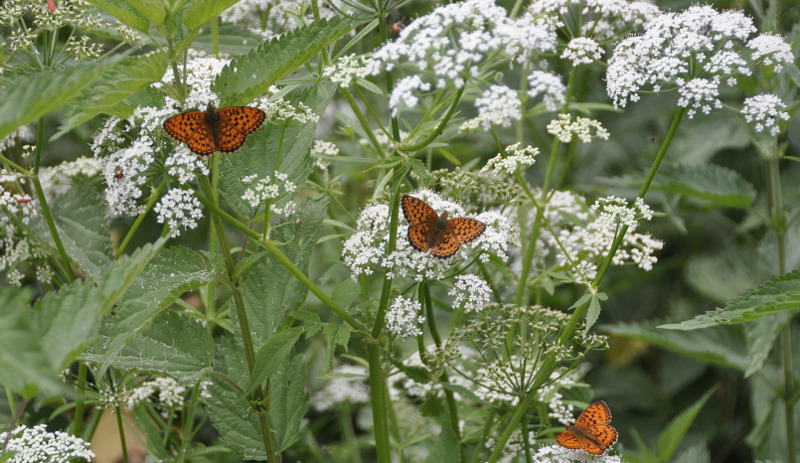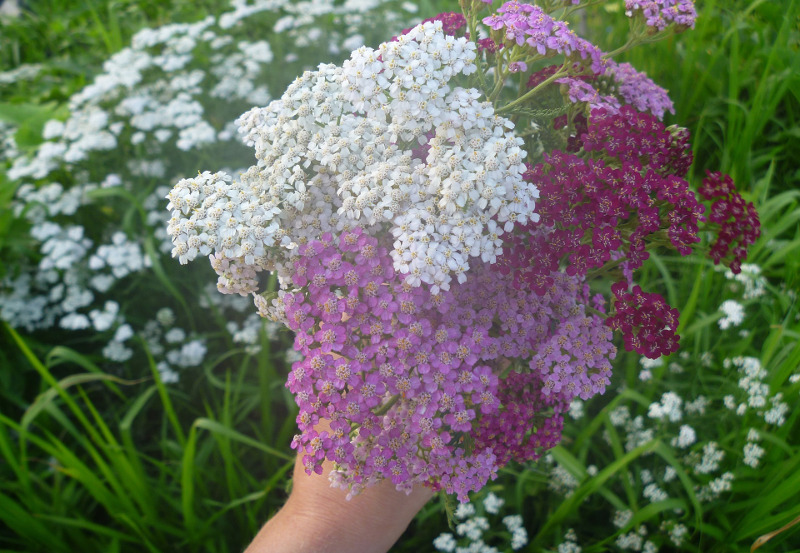Achillea millefolium, commonly known as Yarrow or Common Yarrow, is a flowering plant in the family Asteraceae. It is native to temperate regions of the Northern Hemisphere in Asia and Europe and North America. Yarrow plants have flat topped daisy-like clusters of flowers on fern like foliage. This perennial plant blooms in red, yellow, pink, white and gold. Hardy in USDA zones 3-9, Yarrows are easy to care for and popular with pollinators. This plant prefers full sunlight but can grow in partial shade. Yarrow typically grows 6 inches- 3 feet in height and 2-3 feet wide, making them great for mass plantings, edging, open meadows, edging, contasiners, and dried flowers.

Planting Yarrow
Yarrow is a fast growing plant that can easily spread. When planting, plan to space each plant 1-2 feet apart. Best planted in the spring or early summer, choose an area that receives full sun. This will encourage compact growth; whereas, partial sun can cause the plant to grow leggy. Yarrows do best in average to poor soil that is well drained. Soil too rich can cause overgrowth. Yarrows like hot, dry conditions and will not do well with soggy soil. A dose of fertilizer at planting time can give the plant a good start.
Watering Yarrow
Yarrow plants like dry hot growing conditions and will not thrive in soggy soil. Soil that is well drained is a must. Newly planted Yarrow will need about an inch of water each week until established. This helps to develop strong deep roots. Careful of overwatering and soggy soil, as this can cause the plant to fall over. Typically, if you are getting an inch of rain each week, the plant does not need watering. When you do give your plant additional water, avoid getting the foliage wet.

Fertilizing Yarrow
Yarrow is a low-maintenance, easy to care for-plant. Normally, additional fertilizer is not required. Oftentimes, a layer of compost each year is enough to feed the plant. A soil that is too rich can encourage the plant to spread wild. If your plant appears to be getting a slow start in the spring, an application of fertilizer before new growth appears can help. Use a balanced all purpose fertilizer and follow the packaging directions.
Pruning Yarrow
Regular pruning of your Yarrow can keep the plant in a continuous bloom cycle. Pruning will prevent the plant from self-sowing and becoming invasive. Yarrows can be pruned by about ½ after the first round of flowers to help control the compact shape. If the plant is left in soggy soil for too long, plant stems can flop. Cutting back in late spring can reduce height and avoid flopping. At the end of the growing season, Yarrows can be cut for dried arrangements or pruned down to the ground.

Caring For Yarrow in Pots
Yarrow is an easy to care for plant and can grow in almost any environment, including containers. This plant does best in basic soil, so any standard potting mix will work. When planting, you can mix a slow release fertilizer into the soil to promote quicker growing, as well as each spring to give the plant a boost. Yarrow can grow up to 40 inches tall. To accommodate the growth, choose a container that is at least 5 gallons or bigger with drainage holes. Yarrow does not soggy soil and the plant can fall over if left in those conditions. House your container in full sun for best blooming. A container Yarrow will need fresh soil every few years.
Winter Care for Yarrow
In milder climates, Yarrow leaves stay green all winter. In colder climates, the foliage will die back with a hard freeze. As the temperature drops, and before the first frost, prune the plant back to the basal leaves, 1-2 inches above the soil line. Leaving the basal leaves will help to protect the plant during the winter. Mulching around the base of the plant will help keep the roots moist and insulated from the harsh temperatures. In the later winter or early spring, remove the mulch to allow the plant to begin springtime growth.
Common Yarrow Care Questions
Do Yarrow Plants Spread?
Yarrow does spread, by underground stems and/or from self-sowing. Self-sowing is easy enough to control, by deadheading the spent blooms.
Is Yarrow A Herb?
Yarrow is an herb with the portions of the plant that grow above ground also used by some for medicinal purposes, including for GI tract discomfort, fever, and cold.
What Does A Yarrow Attract?
Yarrow is highly attractive to both bees and butterflies while also being deer and rabbit resistant!
What Is Yarrow Used For?
Yarrow is an herb and is used by some for hay fever, common cold, fevers, anti-diarrheal, and some chew the leaves to help relieve the pain of toothaches.
Does Yarrow Rebloom?
Yarrow flowers will fade and turn brown over the course of the season and you can encourage reblooming by deadheading (removing spent blooms.)
Does Yarrow Need Sun Or Shade?
Yarrow will do best and thrive in full sun. While they will tolerate partial sun or some shade, the stems will become leggy and floppy, while they reach for sunlight.
Does Yarrow Come Back Every Year?
This pollinator attractant is a perennial, coming back year after year.
Why Does Yarrow Leave Turning Brown?
A common cause of brown leaves on yarrow is a powdery mildew infection. Powdery mildew can be caused by too much moisture and not enough air circulation or sunshine.
Have a question about Yarrow? Fill out the form below and we will try and get back to your question as soon as possible. We may even feature your question on this article to help other gardeners!
 |
Author Chris Link - Published 07-08-2021 |
